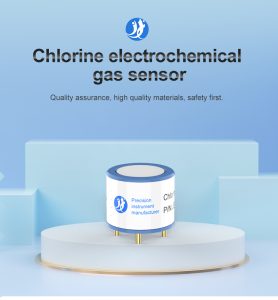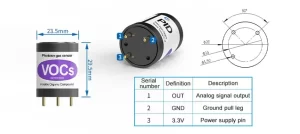Indoor air quality (IAQ) has a significant impact on our health and well-being. With most people spending the majority of their time indoors, it is crucial to ensure that the air we breathe is clean and free from harmful pollutants. Traditional methods of monitoring IAQ have been limited in their accuracy and efficiency. However, with the advent of gas sensor technology, indoor air quality monitoring has undergone a revolution. This article explores the importance of gas sensors in revolutionizing IAQ monitoring, discusses the innovative technologies driving this transformation, and highlights the benefits of adopting these systems for improved health and comfort.

- The Significance of Indoor Air Quality: Indoor air quality refers to the condition of the air within buildings and structures, including homes, offices, schools, and public spaces. Poor IAQ can lead to various health issues, such as respiratory problems, allergies, and even long-term effects like asthma and cardiovascular diseases. Common sources of indoor air pollutants include volatile organic compounds (VOCs), carbon dioxide (CO2), particulate matter (PM), and various gases emitted from building materials, cleaning products, and human activities. Monitoring and maintaining IAQ is essential for creating a healthy and comfortable indoor environment.
- Traditional Challenges in IAQ Monitoring: Traditional methods of IAQ monitoring often relied on periodic sampling or visual inspections, providing limited and delayed information about air quality. These methods were labor-intensive, costly, and unable to capture real-time variations in pollutant levels. As a result, it was challenging to identify and address IAQ issues promptly, potentially leading to prolonged exposure to harmful pollutants. Additionally, traditional monitoring approaches lacked the ability to detect low-level concentrations of gases and VOCs, which can still have adverse health effects.
- Innovative Gas Sensor Technologies: a. VOC Sensors: VOCs are organic compounds that easily vaporize at room temperature, contributing to indoor air pollution. Advanced VOC sensors can detect and quantify the concentration of these compounds in real-time, providing continuous monitoring of IAQ. These sensors use sensitive materials that react to specific VOCs, generating electrical signals proportional to their concentration. By integrating these sensors into IAQ monitoring systems, it becomes possible to identify and mitigate sources of VOC emissions effectively.
b. CO2 Sensors: Carbon dioxide is a byproduct of human respiration and combustion processes. High levels of CO2 can indicate poor ventilation, which can lead to discomfort and impaired cognitive function. CO2 sensors measure the concentration of this gas and provide real-time feedback on indoor air ventilation effectiveness. By monitoring CO2 levels, building managers can adjust ventilation systems to ensure an adequate supply of fresh air, promoting a healthier indoor environment.
c. Particulate Matter Sensors: Particulate matter refers to tiny particles suspended in the air, including dust, pollen, smoke, and other pollutants. Particulate matter sensors measure the size and concentration of these particles, enabling accurate monitoring of indoor air pollution levels. With this information, appropriate filtration systems can be implemented to reduce the presence of harmful particles, improving IAQ.
d. Gas Sensors: Gas sensors are designed to detect and quantify specific gases present in the indoor environment. For example, sensors can identify the presence of carbon monoxide (CO), nitrogen dioxide (NO2), ozone (O3), and other harmful gases. By continuously monitoring gas concentrations, these sensors provide early warnings for potential health hazards and enable timely actions to mitigate risks.
- Benefits and Impacts on Indoor Air Quality: a. Health and Well-being: Gas sensors revolutionize IAQ monitoring by providing real-time data on pollutant levels. This information allows individuals and building managers to take immediate action to improve IAQ, reducing exposure to harmful substances and promoting better health and well-being. By identifying and addressing the sources of indoor air pollution, gas sensors contribute to a healthier indoor environment for occupants.
b. Energy Efficiency: Gas sensors also play a crucial role in optimizing energy usage in buildings. By monitoring IAQ parameters such as CO2 levels, ventilation systems can be adjusted to provide adequate fresh air without excessive energy consumption. This not only improves IAQ but also reduces energy costs and promotes sustainable building practices.
c. Productivity and Comfort: Good IAQ has been linked to improved productivity and cognitive function. By ensuring clean and well-ventilated indoor environments through gas sensor-based monitoring systems, occupants experience increased comfort and concentration, leading to enhanced performance in various settings such as offices, schools, and healthcare facilities.
d. Preventive Maintenance: Gas sensors enable proactive maintenance by providing early detection of potential issues. For example, detecting high levels of CO can indicate malfunctioning combustion systems, allowing for timely repairs or replacements. By addressing problems before they escalate, gas sensors help prevent costly damage and ensure the safety of building occupants.
- Challenges and Future Directions: While gas sensors have revolutionized IAQ monitoring, challenges remain in terms of sensor accuracy, calibration, and long-term reliability. Sensor drift, cross-sensitivity to other gases, and calibration requirements are areas that require ongoing research and development. Additionally, the integration of gas sensors into existing building management systems and the standardization of IAQ monitoring protocols are areas that need attention.
Looking ahead, advancements in gas sensor technology, miniaturization, and wireless connectivity will continue to drive innovation in IAQ monitoring. The development of low-cost, compact sensors with improved accuracy and stability will make these systems more accessible to a wider range of applications and users. Furthermore, the integration of gas sensors with smart building platforms and artificial intelligence algorithms can enhance data analysis capabilities, enabling predictive analytics and proactive IAQ management.

Conclusion: Gas sensors have revolutionized IAQ monitoring by providing real-time, accurate, and continuous data on indoor air pollutants. By detecting and quantifying gases, VOCs, and particulate matter, these sensors enable individuals and building managers to take immediate action to improve IAQ, promoting better health, comfort, and productivity. While challenges exist, ongoing advancements in gas sensor technology and data analysis techniques will drive further innovation in IAQ monitoring systems. By adopting these innovative technologies, we can breathe easy and create healthier indoor environments for everyone.
 : +86 155 8830 2704
: +86 155 8830 2704 : jxdziot@gmail.com
: jxdziot@gmail.com
